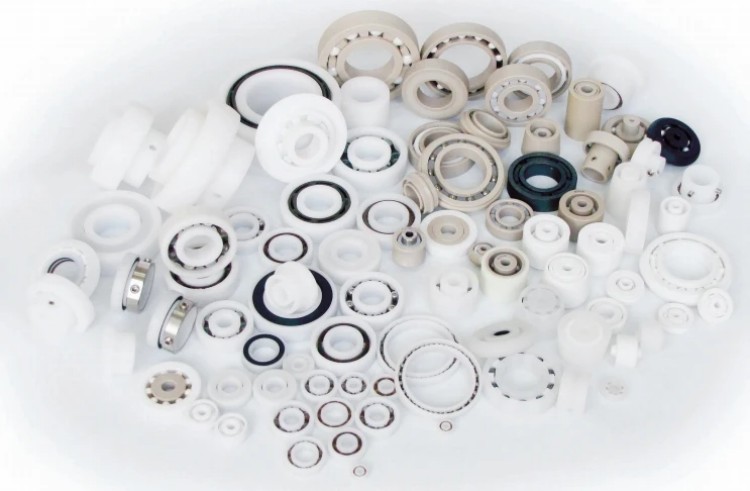Plastic bearings are made of plastic materials and typically consist of a plastic housing, a plastic sleeve, and plastic balls or rollers. They are used to support rotating shafts or other moving parts, enabling them to rotate or move linearly in a relatively fixed position. Below, plastic bearing manufacturers will explain how to identify the quality of custom plastic bearings. You can consider the following aspects:
Appearance Inspection
Surface Quality: High-quality custom plastic bearings should have a smooth and even surface, free of obvious scratches, cracks, bubbles, missing material, flash, or other defects. A rough surface not only affects the bearing's appearance but may also increase the coefficient of friction, affecting its performance and service life.
Color Uniformity: High-quality custom plastic bearings have a uniform, natural color. Significant color variations, spots, or discoloration may be caused by uneven mixing of raw materials or improper processing during production, which can affect the bearing's physical properties and mechanical strength.
Dimensional Accuracy Measurement
Inner Diameter, Outside Diameter, and Width: Use appropriately accurate measuring instruments, such as calipers or micrometers, to measure the inner diameter, outside diameter, and width of the bearing. The dimensional accuracy of high-quality bearings should meet relevant standards and remain within acceptable tolerances. For example, for some high-precision custom plastic bearings, the dimensional deviation between the inner and outer diameters may be controlled within ±0.01mm.
Roundness and Cylindricity: Roundness and cylindricity are important indicators of bearing shape accuracy. Using specialized measuring equipment such as a roundness gauge or cylindricity gauge, bearing roundness and cylindricity errors can be detected. High-quality custom plastic bearings exhibit minimal roundness and cylindricity errors, ensuring a precise fit with the shaft and housing, and reducing vibration and noise.
Material Property Evaluation
Hardness: Generally speaking, custom plastic bearings with higher hardness have better wear resistance and load-bearing capacity. Bearing hardness can be tested using a durometer. Different custom plastic bearing materials have specific hardness ranges. For example, common polytetrafluoroethylene (PTFE) plastic bearings have a lower hardness, typically between 50 and 60 Shore A hardness, while polyimide (PI) plastic bearings have a higher hardness, reaching Shore A hardness of over 100. Density: Density is also an important indicator for evaluating the material performance of custom plastic bearings. High-quality plastic bearing materials have a uniform density that falls within the theoretical density range. Measuring the density of a bearing can provide a preliminary assessment of its material purity and quality. For example, the density of nylon 66 plastic bearings is typically around 1.15-1.16 g/cm². If the measured density differs significantly from the theoretical value, it may indicate impurities or other quality issues.
Mechanical Properties Testing
Load Capacity: Plastic bearings are subjected to load tests using specialized load-bearing testing equipment to observe deformation and failure loads under varying loads. High-quality custom plastic bearings should be able to withstand the required loads without excessive deformation or failure under specified operating conditions. For example, custom plastic bearings used in industrial machinery may require load capacities of tens of kilonewtons or even higher.
Wear Resistance: Wear resistance is a key indicator of the service life of custom plastic bearings. Wear tests can be conducted using friction and wear testing machines that simulate actual operating conditions. After a certain period of testing, the amount of wear and the condition of the worn surface are observed. Plastic bearings with minimal wear and a smooth worn surface exhibit better wear resistance and are therefore considered to be of relatively high quality.
Rotational Flexibility Test
Manual Rotation: Gently rotate the inner or outer ring of the bearing by hand to feel its rotational flexibility. High-quality custom plastic bearings should rotate smoothly and without any binding, sticking, or noticeable changes in resistance. If any sticking or stiffness is felt during rotation, it may indicate impurities within the bearing, improper assembly of parts, or material deformation.
Noise Test: While rotating the bearing, listen carefully for any unusual noises. Good custom plastic bearings should produce a smooth, even, and gentle sound, without noticeable grinding, knocking, or other unusual noises. Excessive noise may indicate insufficient bearing precision, poor fit between parts, or poor material properties.
 |
| If you need any brand bearings or any models of bearings, please contact me!
Contact: Grace |
Jinan Maolei Bearing Co.,Ltd. is china plain bearing supplier for high performance spherical plai...
Miniature ss bearings have many advantages compared with ordinary bearings.Miniature ss bearings ...
sealed ceramic bearings are more and more popular in recent years,they have many advantages compa...
Plastic POM bearing may be usually divided into plastic rolling bearings and plastic slippy beari...
An anti friction bearing that operates below slippery friction.The anti friction bearing works sw...
The clutch pilot bearing is that the 1st shaft guide bearing of the transmission.Between the engi...
Many people do not know the secret of hybrid ceramic balls bearings A. the rolling bearing consis...
Nylon bearings material with smart mechanical strength and wear resistance , appropriate for the ...